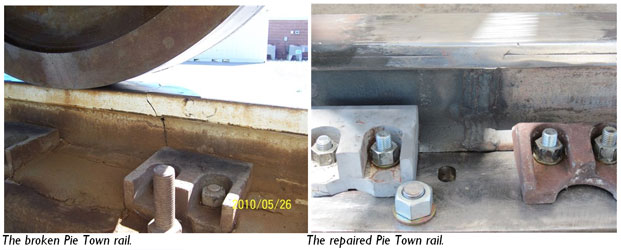NRAO eNews
Volume 3, Issue 8 • September 1, 2010
Upcoming Events
 NRAO Proposal Deadline
NRAO Proposal Deadline
October 1, 2010 5:00 PM EDT
 The 26th Annual New Mexico Symposium
The 26th Annual New Mexico Symposium
November 5, 2010 | Socorro, NM
 NRAO Town Hall - 217th AAS Meeting
NRAO Town Hall - 217th AAS Meeting
January 11, 2011 | 6:30 PM | Seattle, WA
 Early Science with the EVLA - Special Session - 217th AAS Meeting
Early Science with the EVLA - Special Session - 217th AAS Meeting
January 12, 2011 | 10:00 AM | Seattle, WA
 Observing with ALMA - Special Session- 217th AAS Meeting
Observing with ALMA - Special Session- 217th AAS Meeting
January 12, 2011 | 2:00 PM | Seattle, WA
 ALMA: Extending the Limits of Astrophysical Spectroscopy
ALMA: Extending the Limits of Astrophysical Spectroscopy
January 15–17, 2011 | Victoria, British Columbia
NRAO Proposal Evaluation and Time Allocation
K. Y. Lo, Director
The telescope facilities operated by the NRAO are a national resource for enabling the astronomical community to carry out forefront research. The NRAO is currently in transition: the EVLA is now in its Early Science phase and the major new international facility, ALMA, is also about to begin Early Science; both instruments will be fully operational in 2013.
As a means of facilitating the best possible science programs on ALMA and the EVLA, as well as on the GBT and the VLBA, the NRAO is pleased to announce the implementation of a new proposal evaluation and time allocation process for the EVLA, GBT, and VLBA. The development of a new process has been motivated by a number of factors:
- To enhance the simplicity, transparency, and accountability of the proposal handling and time allocation process.
- To provide the wider scientific community with greater ownership of, and responsibility for, the science addressed by NRAO facilities.
- To facilitate proposals which require the use of a combination of the NRAO facilities.
- To bring the proposal cycle into better alignment with other ground based facilities while at the same time remaining sensitive to calls for proposals by space missions and funding agencies.
- To decouple the proposal cycle from operational considerations (e.g., the EVLA configuration cycle) to encourage users to be solely motivated by science imperatives.
The key changes to existing processes and procedures for proposing an observing program on one or more of the instruments operated by the NRAO are, therefore:
- Two calls for proposals each year rather than three calls; i.e., the NRAO will move from a trimester system to a semester system with proposal deadlines on February 1 and August 1 each year.
- Unification of the proposal submission process: a single proposal submission tool is available for the submission of proposals for one or more of the EVLA, GBT, and VLBA.
- Unification of the proposal evaluation process: the NRAO will employ a panel based proposal review system. The Science Review Panels (SRPs) will comprise external members of the community who are experts in the relevant science categories.
- Unification of the time allocation process: a single Time Allocation Committee (TAC) will be responsible for allocations on the EVLA, GBT, and the VLBA.
The new process will be closely analogous to the process for the allocation of time on ALMA.
The new time allocation process will begin with the proposal deadline of February 1, 2011, commensurate with the call for early science proposals on ALMA. On this timescale we expect that the responsibility for the time allocation process on NRAO telescopes will fall to the newly created Observatory Science Operations (OSO). This will be an Observatory-wide coordinated effort to enhance support of the scientific use of NRAO telescope facilities by the astronomical community at large. Additional details about the OSO and the time allocation process will be forthcoming in future eNews articles.
Astro 2010 Reports Available
The Astro2010 Astronomy and Astrophysics Decadal Survey report, "New Worlds, New Horizons in Astronomy and Astrophysics," and the accompanying Astro2010 Panel reports volume are now available for download in pdf format via the National Academies Press website.
A Massive Molecular Gas Reservoir in the Most Distant Sub-mm Galaxy
Dominik Riechers (Hubble Fellow, Caltech) and Chris Carilli (NRAO)
Sub-millimeter galaxies (SMGs) are massive, gas-rich galaxies in the early Universe that undergo the most intense, typically dust-enshrouded star formation events. Since their initial discovery little more than a decade ago, substantial observational and theoretical efforts have gone into determining the key physical properties of these enigmatic systems, and to unravel their role in cosmic star formation and the assembly of the most massive present day galaxies as a whole.
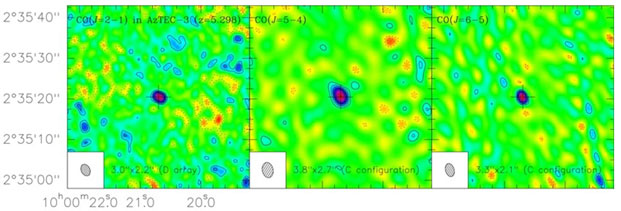
Figure 1: Emission line maps of the CO 2-1, 5-4 and 6-5 lines detected with the EVLA and PdBI. Contours indicate the significance of the emission relative to the noise level. The ellipses (bottom left, each panel) indicate the spatial resolution. The CO 2-1 line would have been inaccessible to the old VLA at this redshift due to the lack of 0.9 cm receivers. Also, in contrast to the previous correlator, the high spectral resolution and broad wavelength coverage of WIDAR allows for an ideal choice for the range over which to extract the emission, maximizing the signal-to-noise ratio in the map.
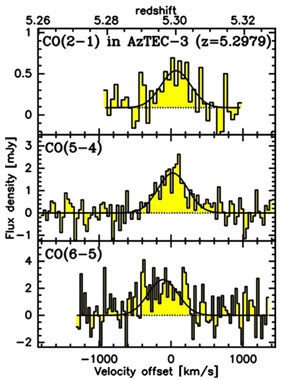
Figure 2: Velocity spectra of the broad CO 2-1, 5-4 and 6-5 line emission. The curves indicate Gaussian-shaped fits to the emission lines. Without WIDAR, only a fifth of the velocity range covered in CO 2-1 could have been observed in one setup. As a result, it would have been impossible to determine the line profile, and a substantial fraction of the line emission would have been missed.
Following our recent discovery of a SMG at an unprecedented redshift of z=5.3, only 1.1 billion years after the Big Bang (Capak et al. 2010), we have used the new capabilities of the Expanded Very Large Array (EVLA) and the Plateau de Bure interferometer (PdBI) to detect CO 2-1, 5-4, and 6-5 emission from its molecular gas reservoir (Riechers et al. 2010). Our observations of this most distant SMG, dubbed AzTEC-3, ultimately confirm the large cosmological distance, making it the most submillimeter-luminous galaxy in a massive z = 5.3 protocluster structure in the COSMOS field.
Enabled by the new EVLA 0.9 cm band, the unprecedented spectral resolution and wavelength coverage of the new EVLA WIDAR correlator, and the recent PdBI correlator upgrade, we were able to study the gas reservoir in this highest redshift SMG in considerable detail. The strength of the CO line emission reveals a large molecular gas reservoir with a mass of 53 billion times the mass of the Sun, which can maintain the intense starburst of 1800 solar masses per year in this system for at least 30 million years, increasing the stellar mass by up to a factor of six in the process.
This gas mass is comparable to “typical” z ~ 2 SMGs in the peak epoch of cosmic star formation, and constitutes approximately 80% or more of the baryonic mass (gas + stars) and more than 30% of the total mass in this galaxy. The molecular gas reservoir has a radius of less than 4 kiloparsecs and likely consists of a diffuse component, containing at least 1/3 of the gas mass, and a dense component, containing up to 2/3 of the mass. The likely presence of a substantial diffuse gas component besides dense gas suggests different properties between the star-forming environments in z > 4 SMGs and z > 4 quasar host galaxies (which we targeted in previous studies with the Very Large Array and Green Bank Telescope), perhaps signifying different stages in the evolution of massive galaxies (early and late, respectively).
The discovery of a massive, metal-enriched gas reservoir in a SMG at the heart of a large z=5.3 protocluster considerably enhances our understanding of early massive galaxy formation, pushing back to a cosmic epoch where the Universe was less than 1/12 of its present age.
The research team included Dominik Riechers, Peter Capak, Nick Scoville, and Lin Yan (Caltech); Chris Carilli (NRAO); Pierre Cox and Roberto Neri (IRAM); Eva Schinner (MPIA); and Frank Bertoldi (University of Bonn, Germany). The scientists report their work in a forthcoming issue of the Astrophysical Journal Letters.
References:
P.L. Capak et al. 2010, submitted to Nature.
D.A. Riechers et al. 2010, ApJ Letters, 720, Issue 2, L131 (arXiv:1008.0389)
Joint NRAO/Fermi Program: Accepted Proposals
Dale A. Frail, Toney Minter, & Tim Bastian
Recognizing the importance of radio observations for reaching the Fermi satellite’s scientific objectives, NRAO and NASA entered into a cooperative arrangement which committed observing time on NRAO telescopes for coordinated observations of Fermi sources, awarded on a competitive basis. Proposals are submitted through the Fermi Guest Investigator program, and successful U.S.-based investigators are eligible for funding through this program. Further details of this program can be found here.
This joint program just competed its third year. We list below the 11 successful joint NRAO/Fermi proposals for this cycle, giving the name of the principle investigator, the proposal title, the total number of hours allocated on NRAO telescopes for each proposal, and the NRAO telescopes requested.
| PI Name | Proposal Title | Hrs | Telescopes |
| Camilo | Radio Timing of Key Fermi Pulsars | 131 | GBT |
| Chatterjee | Precision Distances and Velocities For Fermi-Detected Radio Pulsars | 84 | VLBA |
| Cheung | Prompt Follow-Up of Flaring/Transient Fermi-LAT Galactic Plane Sources | 12 | EVLA |
| Harrison | Fermi GRB Calorimetry With the EVLA And P60 | 80 | EVLA |
| Jorstad | Searching for the Site of Gamma-Ray Emission in Blazar Jets | 54 | EVLA, VLBA |
| Kovalev | 1FGL Active Galactic Nuclei at Parsec Scales | 72 | VLBA+GBT |
| Ojha | Radio Monitoring of Southern Hemisphere Fermi AG | 10 | VLBA |
| Pihlstrom | A New Tracer For Identifying the Sites of Hadronic Cosmic Ray Acceleration | 57.4 | EVLA |
| Ransom | Searching For More Radio Millisecond Pulsars In Fermi Unassociated Sources | 80 | GBT |
| Ray | Search For Radio Pulsations From Gamma-Ray Pulsars Discovered With Fermi | 24 | GBT |
| Savolainen | Filming the Jets of the Archetypical Gamma-Ray Quasars 3C273 and 3C279 at Sub-Parsec Resolution | 144 | VLBA |
EVLA Reaches Theoretical Noise with 2 GHz Bandwidth
Laura Chomiuk (EVLA Resident Shared Risk Observer), Alicia Soderberg (Harvard), Roger Chevalier (Univ. Virginia), Carles Badenes (Chandra Fellow, Princeton), and Claes Fransson (Stockholm Univ.)
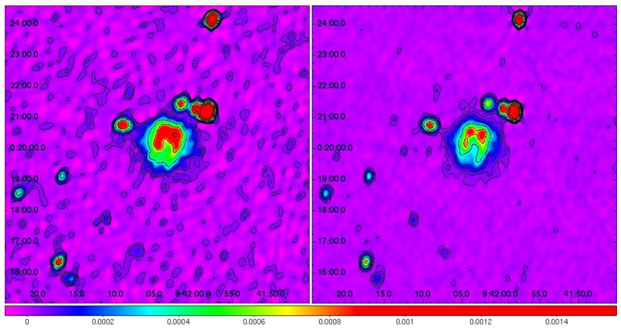
Figure 1: C-band images of spiral galaxy NGC 2967 obtained with EVLA/WIDAR. The left panel shows a 5 GHz image observed in OSRO mode, while the right panel shows an image centered at 6 GHz observed in RSRO mode, achieving almost a factor of three lower rms in the same observing time. Contours in both panels mark the same levels of 3, 6, 12, 24, 48, 96, 192, and 384 times the rms of the RSRO image.
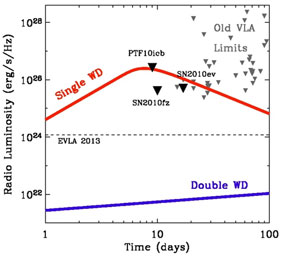
Figure 2: Upper limits on the radio continuum luminosities of Type Ia supernovae compared with model expectations (red line represents the expectation for single degenerate progenitors, while the blue line represents double degenerate progenitors). Grey triangles represent limits observed with the old VLA system, while the black triangles represent the three supernovae we have observed with EVLA/WIDAR (SN2010fz is the first to make use of the full 2 GHz RSRO bandwidth and is the most significant constraint on progenitor models to date).
Deep radio continuum imaging with the EVLA will be a key test of the progenitors of Type Ia supernovae, discriminating between single and double degenerate models for these important but still poorly understood cosmic explosions. As part of our approved Resident Shared Risk Observer (RSRO) project -- "EVLA Can Reveal the Nature of Type Ia Supernova Progenitors" (AS1015) -- we observed the Type Ia supernova SN2010fz on July 11. This supernova is located in the spiral galaxy NGC 2967 at a distance of ~ 30 Mpc. For a check of the EVLA system, we observed it in both Open Shared Risk Observing (OSRO, 256 MHz bandwidth) and RSRO mode (2 GHz bandwidth) with a half hour on source in each. The 5 GHz OSRO image achieved an rms of 19 microJy/beam (Figure 1, left), while the 6 GHz RSRO image had an rms of 7.3 microJy/beam (Figure 1, right), an improvement of sqrt(8) over the OSRO observation, just as theoretically expected.
Also impressive, the EVLA commissioning team was able to acquire these observations just ten days after the explosion of SN2010fz, and on the same day it was optically identified as a Type Ia. As is clear in Figure 2, we expect SNe Type Ia with single-degenerate progenitors to be brightest at early times, peaking ~ 7 days after explosion. The EVLA commissioning team's remarkably rapid response allows us to test a previously unexplored regime in the radio and place more significant constraints on the progenitors of Type Ia supernovae.
ALMA Reaches Seven Antennas
Al Wootten
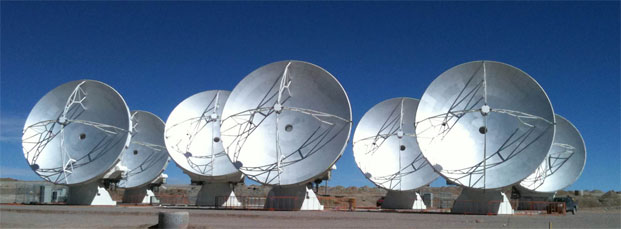
Figure 1: Seven antennas at the 5000m elevation Array Operations Site (AOS) on 10 August 2010. Image courtesy ALMA (ESO/NAOJ/NRAO).
By 8 August, the ALMA array at the high-elevation Array Operations Site (AOS) had grown to seven antennas with the arrival of the sixth Vertex antenna. As the first antennas accepted by ALMA return to the 2900m elevation Operations Support Facility (OSF) for maintenance, the array has entered a period of oscillatory growth. The first Vertex antenna left the array last week for updates, just as the first Mitsubishi antenna had done during July. The array is expected to have eight antennas in September, however, with the return of the first antenna and the delivery to the AOS of another Vertex antenna. A number of commissioning projects have been aided by the more rapid acquisition of data from the larger array.
The ninth Vertex antenna was received at the OSF for testing; and the tenth was moved outside the Vertex Site Erection Facility for initial pointing tests, using a production model of the Optical Pointing Telescope.
As the Array moves closer to the key decision point on the timing of the issuance of the Call for Early Science, preparatory work at the ALMA Research Centers (ARCs) has increased. A number of tests of user software packages are scheduled from the end of August into September to build readiness for the reviews that will occur in October.
The ALMA North American Science Advisory Committee (ANASAC) welcomed six new members: John Carpenter (Caltech), Richard Crutcher (Univ. Illinois), Neal Evans (Univ. Texas), Michael Mumma (GSFC/Univ. Maryland), David Neufeld (Johns Hopkins), and Rachel Osten (STScI). Thanks to retiring committee members Andrew Blain (Caltech), Mike Fall (STScI), Tim Heckman (Johns Hopkins), Shardha Joghee (Univ. Texas), Xavier Prochaska (Lick Obs.) and Alycia Weinberger (OCIW-DTM).
The Astro2010 Committee for a Decadal Survey of Astronomy and Astrophysics published its preliminary report -- "New Worlds, New Horizons in Astronomy" -- on 13 August. The report emphasized ALMA as a key element of astronomy and astrophysics research in the United States during the next decade.
Dr. Lewis Ball will join ALMA on 20 September 2010, via the NRAO, as Deputy Director of the Joint ALMA Observatory. Lewis spent the first part of his career working on topics in the theory of shocks, particle acceleration, synchrotron emission, and inverse Compton scattering and their application to supernovae, supernova remnants, pulsar winds and radio/X-ray transients. He later moved into research management at Australia's Commonwealth Scientific and Industrial Research Organization (CSIRO). There he recently integrated the Australia Telescope National Facility (ATNF) and the Canberra Deep Space Communication Complex (CDSCC) into a new CSIRO division, Astronomy and Space Science. Throughout his career, Lewis has pursued research emphasizing the link between theory and observation, first in magnetospheric physics and later in space physics and astrophysics. With his extensive management expertise, Lewis will strengthen the leadership in ALMA.
The ALMA Explorer: A Virtual Tour
John Stoke

Former North American ALMA Project Director (and ALMA Explorer host) Adrian Russell conducts an interview at the ALMA Array Operations Site technical building.
I’ve yet to meet anyone who has traveled to the ALMA site in northern Chile and not come home with a profound impression of the sheer scale of the project, and of the magnificence of its surroundings. Relatively few among the NRAO’s public audience will ever enjoy the privilege of such a visit, so the EPO team decided to provide the next best thing, a ‘virtual tour’ accessible via web browser.
The ALMA Explorer is now online, our first attempt at turning an astronomy facility and its surroundings into an on-line interpretive experience for casual, armchair tourists. We plan to periodically expand and update it, as well as to create comparable tours for other NRAO research facilities; we’ve already recorded video for an “EVLA Explorer” that will be debut on-line in 2011. (Please note that the ALMA Explorer requires your computer to have the Apple QuickTime player.)
Successful Rail Repair Returns Pie Town to Service
Walter Brisken
The 25 May break in the Pie Town azimuth track (eNews article) caused observing at this VLBA station to be suspended. Uncertainties in the efficacy of the planned fix resulted in return-to-service estimates ranging from 18 June through late July.
One half of the split rail was completely removed from the foundation to allow both halves of the crack to be ground down. Five kilograms of weld-stock were the used to fill the gap. A one-meter stretch of grout under the crack was replaced. Full observing was restored 17 June, a day ahead of the most optimistic estimate!
UVFITS and AIPS data formats
Eric Greisen
We are aware that software systems outside of AIPS and CASA depend on the data formats of AIPS. These formats are written for export in the FITS format as images and uv data, the latter in either random groups or binary table form. Subsidiary information is carried in the form of binary tables with formats closely allied to the internal formats of AIPS tables in most cases. Changes in these formats are made when deemed necessary, but may disrupt usage by outside software packages. Indeed, several changes have been made in the last couple of years as a result of the transition from the VLA to the EVLA, and more changes are expected to support the continued enhancements of the EVLA and VLBA.
We therefore encourage groups whose work would be affected by changes in AIPS data formats to contact egreisen@nrao.edu to provide us with a point of contact for the group and information about which files are potentially important to that group. When changes are contemplated or made, we will then notify such groups directly.
Note that CHANGE.DOC, available on the AIPS web site with cgi-tool access and provided with the "Midnight Job," will remain the primary source of information about changes actually made to AIPS.
From the Archives
Ellen Bouton

About this month's photograph: On 12-15 September 2010, a workshop called SETI @ 50 will be held in Green Bank to celebrate the 50th anniversary of Project OZMA, the first search for extraterrestrial intelligent life, conducted in 1960 using the 85-foot Howard E. Tatel Telescope. This month's photo was taken at the 1985 workshop celebrating the 25th anniversary. Attendees at that workshop who had been part of the Project OZMA team gather in front of the Tatel Telescope. (Front row, left to right) Bob Viers, Dewey Ross, Bill Meredith, Troy Henderson, Bob Uphoff. (Back row, left to right) George Grove, Fred Crews, Omar Bowyer, Frank Drake, Kochu Menon.
From the Archives is an ongoing series illustrating NRAO and U.S. radio astronomy history via images selected from our collections of individuals' and institutional papers. If readers have images they believe would be of interest to the Archives, please contact Ellen Bouton, ebouton@nrao.edu.
Career Opportunities
New Postings
Web Designer: The National Radio Astronomy Observatory in Charlottesville, VA invites applications for the position Web Designer. The Web Designer will work in consultation with the NRAO scientific, technical, and outreach staff to design, develop, and maintain the Observatory's science web site that communicates scientific and technical information to scientific users of the NRAO research facilities. The successful candidate will also work in consultation with a range of Observatory stakeholders to design, develop, and maintain the NRAO Intranet as a visually attractive and effective internal communication tool.
Human Resources Manager – IS: The Joint ALMA Observatory (JAO) in Santiago, Chile is seeking a Human Resources Manager for International Staff and Head of Internal Communications. The successful candidate will report directly to the JAO Director and be a member of the ALMA Human Resources Advisory Group, acting as its Secretary, organizing meetings, suggesting agenda items and presenting status reports to the group. She/he is also responsible for the internal communications inside the JAO and with the ALMA Executives.

 Zoom
Zoom